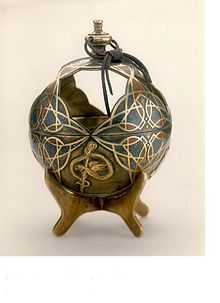Liahona (Book of Mormon)

According to the Book of Mormon and other Latter Day Saint movement sources, the Liahona (/ˈliː.ə.ˈhoʊ.nə/)[1] is a brass ball that operated as a type of compass with two spindles. One of the spindles was said to point the direction Lehi and his party should travel after their escape from Jerusalem. The Book of Mormon states that the Liahona also contained periodic written instructions from God. According to some sources, the Liahona was among the Book of Mormon artifacts Joseph Smith said were found with the golden plates.[2][3]
In Book of Mormon
In the Book of Mormon, the Liahona was found one morning at Lehi's tent door. It is described as a round brass ball of “curious workmanship” with “two spindles,” one of which indicated the direction that his party should travel (1 Nephi 16:10). It is sometimes referred to as a compass, although the context makes it clear that it did not function like a magnetic compass. On occasion there was also writing on the ball that displayed additional instructions from God (1 Nephi 16:26-29). Using the Liahona, Lehi and his party were directed through the wilderness and across the ocean to the Americas. The Liahona worked “according to the faith and diligence” (1 Nephi 16:28) with which they heeded its direction, and ceased functioning at times when the members of the party demonstrated a loss of faith in God's commandments, notably when Nephi's brothers rebelled against Lehi during their ocean crossing (1 Nephi 18:12).
The only place in the Book of Mormon where the word "Liahona" is used is in the Book of Alma, when Alma, speaking to his son Helaman, explains "our fathers called it Liahona, which is, being interpreted, a compass" (Alma 37:38). Alma tells his son that “it is as easy to give heed to the word of Christ ... to eternal bliss, as it was for our fathers to give heed to this compass ... to the promised land“ (Alma 37:44).
Meaning of the word "Liahona"
According to the Book of Mormon, the word Liahona means "a compass" (Alma 37:38). Latter-day Saint scholar Hugh Nibley also provided two additional possibilities for the meaning based on perceived Hebrew roots:
“Many people have dealt with the word Liahona. We had a teacher from Hebrew University here for a few years …. His name was Shunary. He never joined the Church, but the first thing that fascinated him was this name Liahona. He traced it back to the queen bee, the leader of bees swarming in the desert. When bees swarm, that's Liahona. I took it from a different one. Yah is, of course, God Jehovah. Liyah means the possessive, "To God is the guidance," hona (Liyahhona). That's just a guess; don't put it down. But it's a pretty good guess anyway".[4]
Jonathan Curci suggested that the word means "the direction of the Lord".[5]
See also
References
- ↑ "Book of Mormon Pronunciation Guide", lds.org (retrieved 2012-02-25), IPA-ified from «lē´a-hō´na»
- ↑ Lapham, [La]Fayette (1870), "Interview with the Father of Joseph Smith, the Mormon Prophet, Forty years Ago. His Account of the Finding of the Sacred Plates", Historical Magazine [second series] 7: 306–308
- ↑ Salisbury, Katharine Smith (April 10, 1895), Walker, Kyle R., ed., "Katharine Smith Salisbury's Recollections of Joseph's Meetings with Moroni" (PDF), BYU Studies (2002) 41 (3): 13
- ↑ Nibley, Hugh. Teachings of the Book of Mormon, Semester 1, p.216. Covenant Communications (2004). ISBN 978-1-59156-571-0
- ↑ Jonathan Curci, "Liahona: 'The Direction of the Lord': An Etymological Explanation", Journal of Book of Mormon Studies 16(2) (2007): 60–67.
Further reading
- Wells, Robert E. (2003). "The Liahona Triad". A Book of Mormon Treasury: Gospel Insights from General Authorities and Religious Educators. Provo, Utah: Religious Studies Center, Brigham Young University. p. 80–96. ISBN 1-59038-099-1.
External links
 Media related to Liahona (Book of Mormon) at Wikimedia Commons
Media related to Liahona (Book of Mormon) at Wikimedia Commons